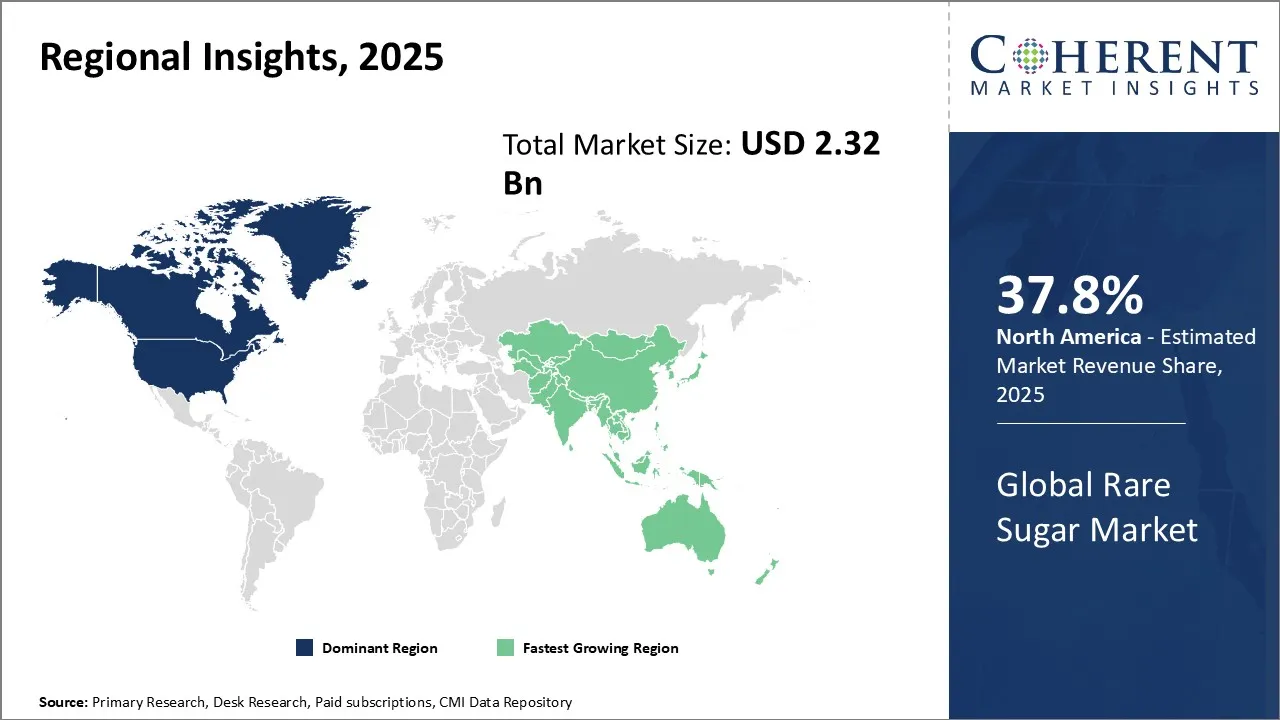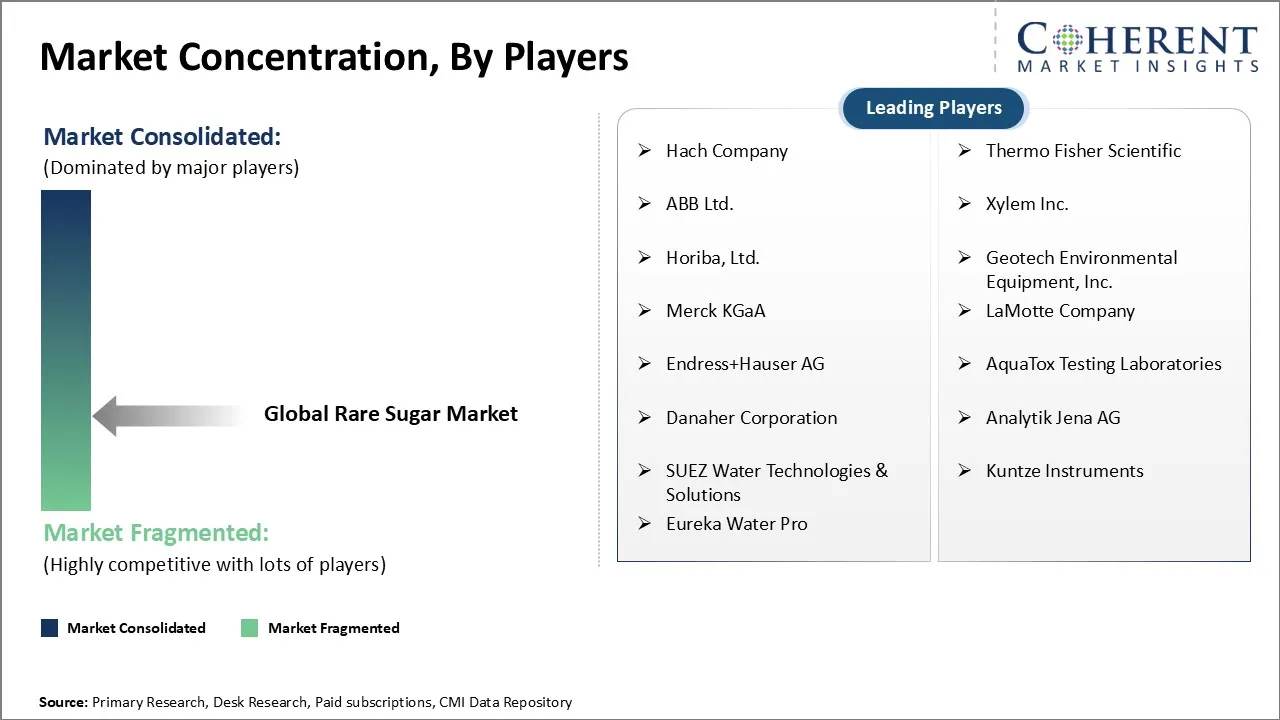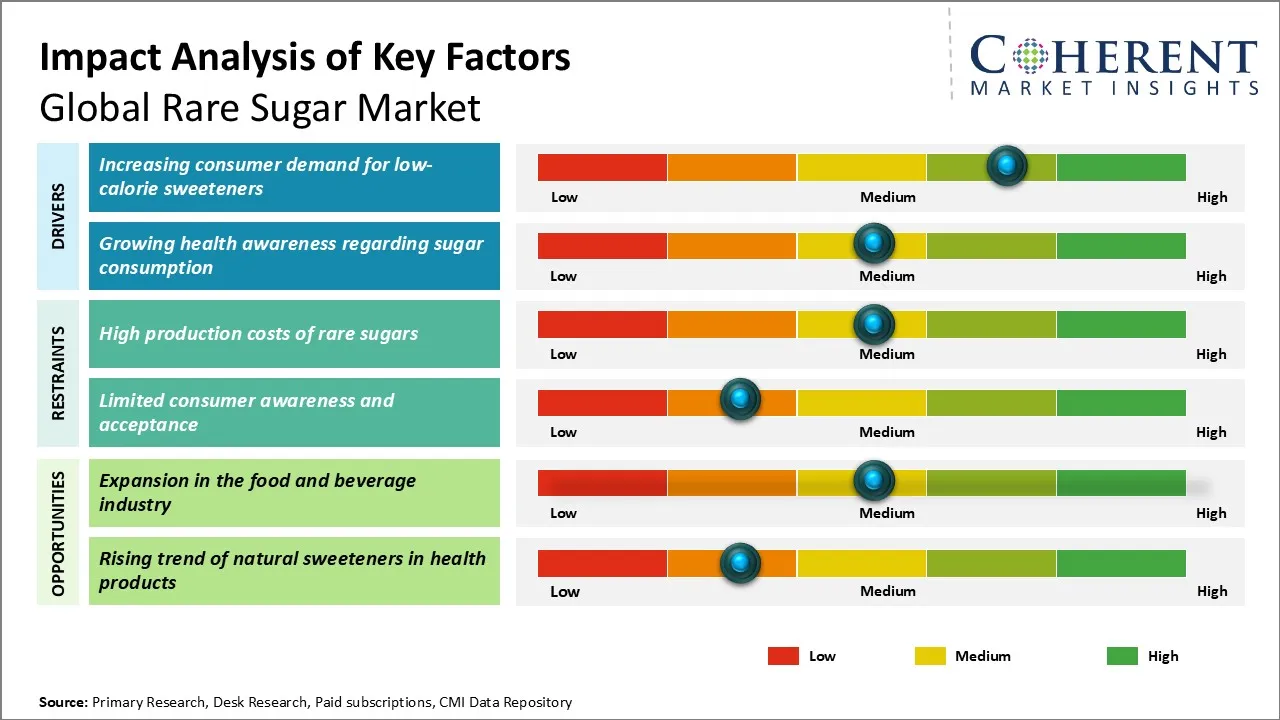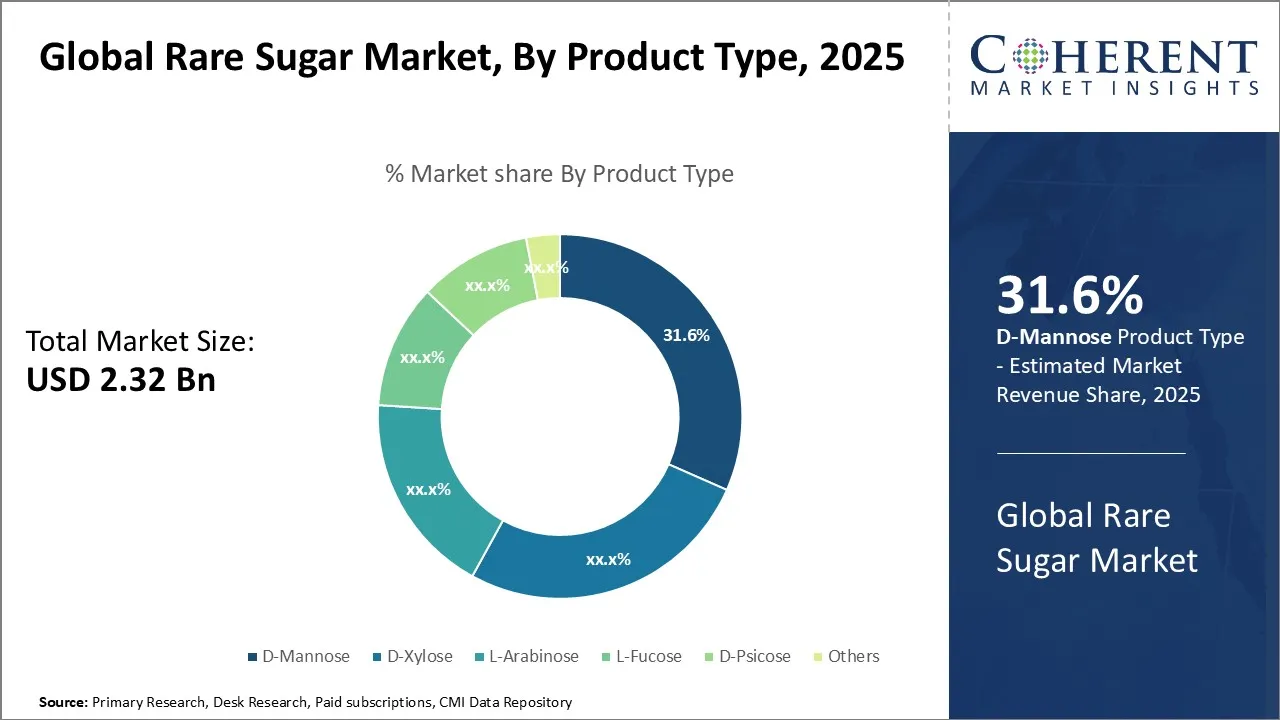Global Rare Sugar Market Size and Forecast – 2025-2032
The Global Rare Sugar Market is estimated to be valued at USD 2.32 Bn in 2025 and is expected to reach USD 3.46 Bn by 2032, exhibiting a compound annual growth rate (CAGR) of 5.9% from 2025 to 2032.
Key Takeaways of the Rare Sugar Market :
- D-mannose is expected to capture 31. 6% of the global rare sugar market in 2025.
- The food and beverages segment is projected to hold 39. 7% of the rare sugar market in 2025.
- Online retail is expected to hold a 34. 6% share of the global rare sugar market in 2025.
- North America is set to lead the global rare sugar market in 2025 with a 37. 8% share. Asia Pacific, with a 13.5% share in 2025.
Market Overview:
Market trends indicate a growing preference for natural and functional ingredients, with rare sugars gaining traction due to their unique health benefits, such as low glycemic index and prebiotic properties. Innovations in biotechnological production methods are further enhancing supply capabilities and reducing costs. Additionally, expanding applications in dietary supplements and diabetic-friendly products are expected to fuel market expansion, while regulatory support for natural sweeteners continues to encourage wider market adoption.
Currents Events and their Impact
|
Current Events |
Description and its impact |
|
Rising Prevalence of Diabetes and Obesity |
|
|
Advancements in Rare Sugar Production Technology |
|
Uncover macros and micros vetted on 75+ parameters: Get instant access to report
Rare Sugar Market Insights, By Product Type – The Dominance of D-Mannose in Rare Sugar Product Type is Driven by its Therapeutic and Functional Benefits
D-Mannose is expected to hold 31.6% share within the global rare sugar market in 2025, primarily influenced by its extensive applications across therapeutic and nutritional domains. D-Mannose is renowned for its unique bioactive properties, especially in urinary tract health, which significantly boosts its demand in pharmaceutical and dietary supplement segments. The growing awareness about natural alternatives to antibiotics for preventing urinary tract infections (UTIs) has driven healthcare providers and consumers alike to prefer D-Mannose supplements, reinforcing its market leadership in the rare sugar category.
Beyond its medicinal value, D-Mannose exhibits excellent functional attributes that support its proliferation in food and beverage formulations. It acts as a low-calorie sweetener and demonstrates prebiotic potential by stimulating the growth of beneficial gut microbiota, aligning perfectly with consumer trends leaning toward gut health and digestive wellness. Manufacturers are increasingly incorporating D-Mannose into health drinks, functional foods, and nutritional bars, leveraging its dual role as both a health-enhancing ingredient and a sugar alternative that does not raise glycemic response significantly.
Rare Sugar Market Insights, By Application - Food and Beverages Segment is Leading Due to Rising Consumer Demand for Natural and Health-Focused Sweeteners
The food and beverages segment is expected to contribute 39.7% share of the market in 2025, among applications of rare sugars, primarily driven by the shifting consumer preferences toward natural, low-calorie, and functional sweeteners. Increasing health consciousness globally has stimulated the demand for ingredients that can deliver sweetness while minimizing the negative health impacts of traditional sugars, such as obesity, diabetes, and metabolic disorders. Rare sugars fit this niche effectively, providing manufacturers with alternatives that satisfy sweetness needs without compromising on health attributes.
Rare Sugar Market Insights, By Distribution Channel - Online Retail Channels Lead Owing to Convenience and Expanding Health-Conscious Consumer Base
Online retail is expected to command 34.6% share in the global rare sugar market in 2025, propelled by its unmatched convenience and expanding accessibility to health-conscious consumers. The surge in e-commerce platforms offering specialty nutritional products has revolutionized consumer buying behavior, enabling easier access to rare sugar-based products that were previously limited to physical specialty stores or niche markets. Online retail’s capacity to reach a wide, geographically diverse audience facilitates increased penetration for rare sugars, particularly in emerging markets.
Evolving digital ecosystems facilitate extensive product information dissemination, consumer education, and direct-to-consumer marketing, which are vital drivers in promoting awareness about the benefits of rare sugars. Online platforms often offer detailed descriptions, scientific research references, and user reviews, which instill confidence among consumers who are increasingly making informed purchasing decisions based on health benefits and ingredient transparency. This level of engagement is difficult to replicate in traditional brick-and-mortar stores.
Regional Insights:

To learn more about this report, Download Free Sample
North America Rare Sugar Market Analysis and Trends
The North America region is projected to lead the market with a 37.8% share in 2025. The region benefits from a mature regulatory environment that supports the development and commercialization of safe, natural food ingredients. Government agencies such as the USFDA have enabled the market by establishing clear guidelines on rare sugar usage, allowing innovative companies to bring products to market efficiently.
Major players including Ingredion Incorporated, Tate & Lyle, and Cargill focus on advanced fermentation-based technologies to optimize rare sugar production. Additionally, the presence of large-scale food and beverage manufacturers leveraging rare sugars in low-calorie, diabetic-friendly, and functional food products expands market adoption. Trade dynamics also favor North America, as it imports cutting-edge technologies while exporting finished products globally.
Asia Pacific Rare Sugar Market Analysis and Trends
The Asia Pacific region is expected to exhibit the fastest growth in the market contributing 13.5% share in 2025. The widespread cultivation of sugar-rich crops such as sugarcane and corn provides abundant raw materials essential for rare sugar production. Additionally, several governments in the region actively support biotechnology and natural sweetener sectors through favorable policies and subsidies, encouraging innovation and investment.
Countries like Japan and South Korea are home to leading biotech firms such as Matsutani Chemical Industry Co., Ltd. and CJ CheilJedang, which have pioneered enzymatic rare sugar production techniques. The region's integrated supply chains, significant consumer awareness about health and low-calorie foods, and increasing applications of rare sugars in pharmaceuticals and functional foods further consolidate its leadership position. Furthermore, Asia Pacific’s export-oriented trade infrastructure facilitates global distribution, enhancing the market’s international footprint.
Rare Sugar Market Outlook for Key Countries
Japan Rare Sugar Market Trends
The Japan rare sugar market thrives due to strong government support for biotechnology innovations and a long-standing consumer preference for low-calorie and functional sweeteners. Companies like Matsutani Chemical Industry Co., Ltd. and Saitama Koyo Co. play significant roles in developing and commercializing rare sugars such as D-psicose and D-allulose. Japan’s well-established infrastructure for food innovation and regulatory framework ensures quick adoption and integration of rare sugars across food, pharmaceutical, and cosmetic industries.
U.S. Rare Sugar Market Trends
The U.S. rare sugar market is characterized by high consumer interest in clean-label and health-oriented ingredients, fueling the demand for rare sugars in various applications. Key industry players such as Ingredion Incorporated and Tate & Lyle have invested heavily in research to develop commercially viable rare sugars through enzymatic and fermentation processes. The U.S. benefits from advanced supply chain networks and collaborations between biotech firms and food manufacturers, accelerating product penetration in mainstream and niche markets.
China Rare Sugar Market Trends
China rare sugar market is rapidly expanding, fueled by extensive agricultural resources and increasing investments in biotechnology. The government’s push towards sustainable agriculture and natural ingredient usage aligns with rare sugar production development. Domestic players, often in partnership with international firms, are improving rare sugar extraction and synthesis techniques. Growing urban populations and shifting dietary patterns towards healthier options also contribute to the rising demand for rare sugars in food and beverage applications.
For example, Shandong Futaste Co., Ltd. is a leading Chinese manufacturer specializing in rare sugars and sugar alcohols. Developing advanced enzymatic and fermentation technologies to produce rare sugars such as allulose, tagatose, and erythritol more efficiently and sustainably.
Germany Rare Sugar Market Trends
Germany rare sugar market reflects strong industrial and scientific capabilities, with an emphasis on quality and innovation. Companies, such as Südzucker AG and Südstärke GmbH, produce rare sugars used in the food, pharmaceutical, and cosmetic sectors. Germany’s supportive regulatory environment and active participation in European Union research initiatives facilitate continuous advancements. The country serves as a hub for rare sugar innovation in Europe, driving regional market growth and cross-border distribution networks.
Macro-Economic Factors Impacting Rare Sugar Market
Microeconomic Factors:
- Production Costs: Manufacturing rare sugars involves complex processes, leading to high prices ranging from USD 100 to USD 500 per kilogram due to enzymatic conversion and limited raw material availability.
- Consumer Demand: Rising health consciousness fuels demand for low-calorie alternatives like allulose and tagatose, particularly in functional foods and dietary supplements.
Macroeconomic Factors:
- Regulatory Policies: Evolving frameworks by the FDA and EFSA impact market accessibility, with compliance costs affecting scalability.
- Economic Disruptions: Events like the Russia-Ukraine war cause inflation and supply chain constraints, hindering growth.
Market Players, Key Development, and Competitive Intelligence:

To learn more about this report, Download Free Sample
Key Developments:
- In April 2025, a study published in the Nutrition journal by researchers in Japan highlighted the potential of rare sugars in managing metabolic diseases. The research evaluated the effects of two aldohexoses and four ketohexoses, including three rare sugars (D-allulose, D-tagatose, and D-sorbose) and the common sugar D-fructose, on glucagon-like peptide-1 (GLP-1) secretion and food intake in male murine models. The findings revealed that these ketohexoses, along with D-fructose, significantly enhanced GLP-1 hormone release and reduced food intake in the mice, suggesting their promise as next-generation interventions for type 2 diabetes (T2D), obesity, and other metabolic disorders.
- In August 2024, new research from Toronto Metropolitan University (TMU) revealed that allulose, a rare sugar, could be a breakthrough for managing blood sugar levels. Led by TMU School of Nutrition Professor Nick Bellissimo, the study demonstrated that adding small amounts of allulose to food can significantly reduce post-meal sugar spikes. Allulose, a naturally occurring sugar found in foods like figs, raisins, and maple syrup, shares a chemical structure similar to fructose. The findings have the potential to help individuals manage blood sugar levels and reduce calorie intake, offering a promising new tool for those with blood sugar concerns.
Top Strategies Followed by Global Rare Sugar Market Players
- Established players dominate the market through substantial investments in research and development (R&D), driving innovation to develop high-performance rare sugar variants that cater to evolving consumer demands for healthier and functional sweeteners. These companies leverage their R&D capabilities not only to enhance product efficacy and safety but also to diversify their product portfolios, encompassing a variety of rare sugars such as tagatose, allulose, and psicose.
- For instance, Ingredion, a global player in the food ingredient market, developed allulose as a low-calorie sweetener, investing in significant R&D to improve its manufacturing processes. This enables Ingredion to diversify its product portfolio, which now includes tagatose and psicose, alongside allulose, to meet a broader spectrum of consumer needs.
- Mid-level players in the rare sugar market adopt a different competitive approach by focusing primarily on providing cost-effective solutions that strike a balance between quality and affordability. This strategy targets price-sensitive consumers and manufacturers looking for economical alternatives to conventional sweeteners without compromising essential functional attributes.
- For example, Sweetener Supply, a mid-tier player, focuses on producing tagatose at a competitive price point, positioning itself as an affordable alternative to high-cost sweeteners like stevia. This approach appeals to consumers and manufacturers looking for budget-friendly options without sacrificing taste and performance. By adopting innovative manufacturing methods and optimizing production processes, Sweetener Supply can keep costs low while maintaining product efficacy.
- Small-scale players, although limited in resources compared to their larger counterparts, carve out niches within the rare sugar market by focusing on specialized features or innovative product variants that address specific consumer needs or regulatory requirements. These players are often more agile and responsive, adopting cutting-edge technologies such as enzyme engineering, fermentation optimization, or novel extraction techniques to develop unique rare sugar offerings.
- For instance, NutraSweet, a small-scale company, leverages enzyme engineering to optimize the production of rare sugars such as allulose through fermentation. This novel approach allows NutraSweet to offer unique variants of rare sugars that have superior taste profiles and functional benefits compared to conventional sweeteners.
Market Report Scope
Rare Sugar Market Report Coverage
| Report Coverage | Details | ||
|---|---|---|---|
| Base Year: | 2024 | Market Size in 2025: | USD 2.32 Bn |
| Historical Data for: | 2020 To 2024 | Forecast Period: | 2025 To 2032 |
| Forecast Period 2025 to 2032 CAGR: | 5.9% | 2032 Value Projection: | USD 3.46 Bn |
| Geographies covered: |
|
||
| Segments covered: |
|
||
| Companies covered: |
Sweet Cures, DuPont de Nemours Inc., Specom Biochemical, ASTRAEA Allulose, Naturesupplies, Douglas Laboratories, Matsutani Chemical Industry Co. Ltd., Hebei Huaxu, and Sanwa Starch |
||
| Growth Drivers: |
|
||
| Restraints & Challenges: |
|
||
Uncover macros and micros vetted on 75+ parameters: Get instant access to report
Rare Sugar Market Dynamics

To learn more about this report, Download Free Sample
Rare Sugar Market Driver - Increasing Consumer Demand for Low-calorie Sweeteners
The growing awareness among consumers about the adverse health effects of excessive sugar intake has significantly driven the demand for low-calorie sweeteners, fueling the prominence of rare sugars in the global market. As individuals increasingly seek healthier dietary alternatives, rare sugars, which offer similar sweetness with fewer calories, have emerged as a preferred option. These sugars not only cater to diabetic and obese populations but also attract health-conscious consumers looking for naturally derived, low-glycemic ingredients to manage weight and blood sugar levels.
For example, Allulose, a rare sugar, is gaining traction in beverage products like diet sodas and sugar free energy drinks, where it is used as a natural, low-calorie sweetener that helps reduce the calorie count without sacrificing sweetness. A prime example is Coca-Cola, which has incorporated allulose in some of its sugar-free product lines to cater to health-conscious consumers.
Rare Sugar Market Opportunity - Expansion in the Food and Beverage Industry
The global rare sugar market presents significant growth opportunities driven by the expanding food and beverage sector, which increasingly demands healthier and innovative ingredients. Rare sugars, known for their low caloric value, unique sweetness profiles, and potential health benefits such as low glycemic indexes, are gaining traction as alternatives to conventional sugars. This shift is fueled by rising consumer awareness about metabolic health issues, such as diabetes and obesity, prompting manufacturers to reformulate products with ingredients that deliver sweetness without compromising health.
For instance, beverage manufacturers are utilizing allulose in sports drinks and flavored waters because it provides sweetness without contributing to blood glucose spikes, while bakery companies are adopting rare sugars to create guilt-free desserts that align with clean-label trends. According to the World Health Organization's 2022 report on sugar intake recommendations, countries implementing sugar taxes and health policies have accelerated industry innovation toward alternative sweetening solutions, creating substantial demand for rare sugar applications across diverse food categories.
Analyst Opinion (Expert Opinion):
- The rare sugar market is on the cusp of substantial growth, driven by the increasing consumer demand for healthier sweetening alternatives and the rise of low-calorie diets. Companies like Mizuna and Tate & Lyle are leading innovations in extracting and commercializing rare sugars, such as allulose and tagatose, which offer significant advantages over traditional sweeteners.
- Recent conferences, such as the International Sweeteners Association Conference (2023) and the Food Ingredients Europe (2022), have highlighted the potential of rare sugars in enhancing product formulations while meeting consumer preferences for clean labels and health benefits. These events have showcased successful applications in various food and beverage products, emphasizing the role of rare sugars in reducing overall sugar intake without compromising taste. As health-conscious consumers continue to seek better alternatives, the rare sugar market is well-positioned for significant expansion, driven by innovations that cater to both taste and nutritional needs.
Market Segmentation
- Product Type Insights (Revenue, USD Bn, 2020 - 2032)
-
- D-Mannose
- D-Xylose
- L-Arabinose
- L-Fucose
- D-Psicose
- Others
- Application Insights (Revenue, USD Bn, 2020 - 2032)
-
- Food and Beverages
- Pharmaceuticals
- Dietary Supplements
- Cosmetics
- Distribution Channel Insights (Revenue, USD Bn, 2020 - 2032)
-
- Online Retail
- Supermarkets/Hypermarkets
- Health Food Stores
- Specialty Stores
- Regional Insights (Revenue, USD Bn, 2020 - 2032)
-
- North America
- U.S.
- Canada
- Latin America
- Brazil
- Argentina
- Mexico
- Rest of Latin America
- Europe
- Germany
- U.K.
- Spain
- France
- Italy
- Russia
- Rest of Europe
- Asia Pacific
- China
- India
- Japan
- Australia
- South Korea
- ASEAN
- Rest of Asia Pacific
- Middle East
- GCC Countries
- Israel
- Rest of Middle East
- Africa
- South Africa
- North Africa
- Central Africa
- North America
- Key Players Insights
- Sweet Cures
- DuPont de Nemours Inc.
- Specom Biochemical
- ASTRAEA Allulose
- Naturesupplies
- Douglas Laboratories
- Matsutani Chemical Industry Co. Ltd.
- Hebei Huaxu
- Sanwa Starch
Sources:
Primary Research Interviews:
- R&D Director – Leading Liquid Vitamin Manufacturer
- Procurement Manager – Major Dietary Supplement Retailer
- Product Development Head – Well-Known Vitamin Brand
- Sustainability Manager – Health Supplement Certification Body
Stakeholders:
- Manufacturers
- End-use Sectors:
- Dietary Supplements (Vitamins, Minerals, Nutritional Drinks)
- Fitness & Wellness Brands focusing on liquid supplementation
- Regulatory & Certification Bodies
- E-commerce Platforms and Retailers
- Technology Integration Players: AI-based personalization providers for nutritional products
Databases:
- UN Comtrade Database
- India Import Export (EXIM) Database
Magazines:
- Nutrition & Wellness Magazine – Trends in dietary supplements and liquid vitamins
- Health & Nutrition Business – Innovations in liquid nutrition and supplements
- Global Health Insights – Consumer health trends in vitamin consumption
- Vitamin Business Journal – Market updates and growth opportunities in liquid vitamins
- The Supplement Guide – Industry updates for dietary supplements and liquid formulations
Journals:
- International Journal of Nutrition – Nutritional benefits and absorption of liquid vitamins
- Journal of Food Science & Technology – Formulation trends in vitamin products
- Journal of Dietary Supplements – Effects of liquid supplementation on health
- Journal of Applied Nutrition – Benefits of liquid vitamins in nutrition
- Food Research International – Nutrient bioavailability in liquid supplements
Newspapers
- The Financial Times – Market growth of liquid vitamins and nutritional products
- The Guardian – Consumer trends in health and wellness supplements
- Asia Health Journal – Growth of liquid vitamin consumption in the Asia-Pacific region
- European Nutrition News – Liquid vitamins regulation and health policies
- The New York Times – Consumer preference shift to liquid supplementation
Associations:
- Council for Responsible Nutrition (CRN)
- International Society of Nutraceuticals and Functional Foods (ISNFF)
- American Herbal Products Association (AHPA)
- Natural Products Association
- European Food Safety Authority (EFSA)
- Clean Label Project
Public Domain Sources
- FDA – Guidelines for dietary supplements, including liquid vitamins
- European Commission – Food Supplements Regulation and Vitamin Guidelines
- World Health Organization – Safety standards and health impact studies on vitamins
- OECD – Nutritional and safety assessments for food supplements
Proprietary Elements:
- CMI Data Analytics Tool, Proprietary CMI Existing Repository of information for last 8 years.
Share
Share
About Author
Sakshi Suryawanshi is a Research Consultant with 6 years of extensive experience in market research and consulting. She is proficient in market estimation, competitive analysis, and patent analysis. Sakshi excels in identifying market trends and evaluating competitive landscapes to provide actionable insights that drive strategic decision-making. Her expertise helps businesses navigate complex market dynamics and achieve their objectives effectively.
Missing comfort of reading report in your local language? Find your preferred language :
Transform your Strategy with Exclusive Trending Reports :
Frequently Asked Questions
EXISTING CLIENTELE
Joining thousands of companies around the world committed to making the Excellent Business Solutions.
View All Our Clients


